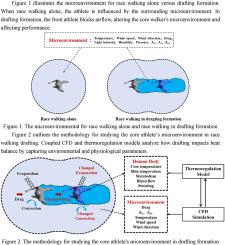通过 CFD 和体温调节耦合模型评估牵引编队对运动员热动力学和运动表现的影响
IF 4.9
2区 工程技术
Q1 ENGINEERING, MECHANICAL
International Journal of Thermal Sciences
Pub Date : 2024-11-08
DOI:10.1016/j.ijthermalsci.2024.109510
引用次数: 0
摘要
研究表明,牵拉可以提高各种运动的成绩。目前的研究集中于牵拉对减少阻力的影响,而对体温调节和出汗的研究有限。本文利用 CFD 和体温调节模型探讨了牵拉阵型如何影响运动员的微环境。考虑到减少阻力对机械功的影响,本研究探讨了牵拉如何在保持核心和皮肤温度一致的情况下影响热量产生、散失和出汗。单独竞走时的平均 hc 最高,为 37.34,其次是双编队 1、2 和 3,分别为 36.34、36 和 34.74。这意味着分别下降了 2.7%、3.6% 和 7%。这些降低可归因于在主流中观察到的较低雷诺数和湍流扩散系数。与单独竞走相比,在不同距离的双人编队中,核心运动员的出汗散热量分别增加了 0.23 %、0.24 % 和 0.28 %,皮肤血流量分别增加了 0.31 %、0.39 % 和 0.65 %。此外,骨盆被认为是受影响最大的部位。然而,阻力的减少会导致代谢产热减少,从而导致出汗和皮肤血流量减少。与单独竞走相比,在不同距离的双人编队中,出汗散热量分别减少了 3.44 %、4.71 % 和 6.72 %,而皮肤血流量则分别减少了 3.16 %、4.38 % 和 6.39 %。这些变化对性能产生了积极影响。此外,阻力减少率与皮肤血流量和出汗散热量的百分比差异成反比,负相关系数分别为 0.116 和 0.119。因此,本文强调了牵拉如何减少出汗和皮肤血流量,突出了体温调节的重要性,并为训练和水合策略提供了宝贵的指导。本文章由计算机程序翻译,如有差异,请以英文原文为准。

Evaluating the effects of drafting formations on athletes' heat dynamics and performance via coupled CFD and thermoregulation model
Research indicates that drafting enhance performance across various sports. Current studies concentrate on drafting impact on reducing drag, with limited research on thermoregulation and sweating. This article explores how drafting formations affect the athlete's microenvironment using CFD and thermoregulation model. This study investigates how drafting influences heat production, dissipation, and sweating while maintaining consistent core and skin temperature, considering the impact of drag reduction on mechanical work. The average during race walking alone is the highest at 37.34, followed by double formations 1, 2, and 3, which are 36.34, 36, and 34.74 respectively. This represents a decrease of 2.7 %, 3.6 %, and 7 %. These reductions can be attributed to the lower Reynolds number and turbulent diffusion coefficient observed in the mainstream. Compared to race walking alone, in double formations with varying distances, core athlete experienced increased sweating heat dissipation by 0.23 %, 0.24 %, 0.28 %, and skin blood flow by 0.31 %, 0.39 %, 0.65 %. Additionally, the pelvis is identified as the most impacted area. However, reduced drag leads to less metabolic heat production, resulting in decreased sweating and skin blood flow. Compared to race walking alone, the sweating heat dissipation is reduced by 3.44 %, 4.71 %, and 6.72 % in double formations at varying distances, while skin blood flow is reduced by 3.16 %, 4.38 %, and 6.39 %. These changes positively impact performance. Additionally, the drag reduction rate is inversely correlated with the percentage difference in skin blood flow and sweating heat dissipation, with negative correlation coefficients of 0.116 and 0.119, respectively. Therefore, this article emphasizes how drafting reduces sweating and skin blood flow, highlights the importance of thermoregulation, and offers valuable guidance for training and hydration strategy.
求助全文
通过发布文献求助,成功后即可免费获取论文全文。
去求助
来源期刊

International Journal of Thermal Sciences
工程技术-工程:机械
CiteScore
8.10
自引率
11.10%
发文量
531
审稿时长
55 days
期刊介绍:
The International Journal of Thermal Sciences is a journal devoted to the publication of fundamental studies on the physics of transfer processes in general, with an emphasis on thermal aspects and also applied research on various processes, energy systems and the environment. Articles are published in English and French, and are subject to peer review.
The fundamental subjects considered within the scope of the journal are:
* Heat and relevant mass transfer at all scales (nano, micro and macro) and in all types of material (heterogeneous, composites, biological,...) and fluid flow
* Forced, natural or mixed convection in reactive or non-reactive media
* Single or multi–phase fluid flow with or without phase change
* Near–and far–field radiative heat transfer
* Combined modes of heat transfer in complex systems (for example, plasmas, biological, geological,...)
* Multiscale modelling
The applied research topics include:
* Heat exchangers, heat pipes, cooling processes
* Transport phenomena taking place in industrial processes (chemical, food and agricultural, metallurgical, space and aeronautical, automobile industries)
* Nano–and micro–technology for energy, space, biosystems and devices
* Heat transport analysis in advanced systems
* Impact of energy–related processes on environment, and emerging energy systems
The study of thermophysical properties of materials and fluids, thermal measurement techniques, inverse methods, and the developments of experimental methods are within the scope of the International Journal of Thermal Sciences which also covers the modelling, and numerical methods applied to thermal transfer.
 求助内容:
求助内容: 应助结果提醒方式:
应助结果提醒方式:


